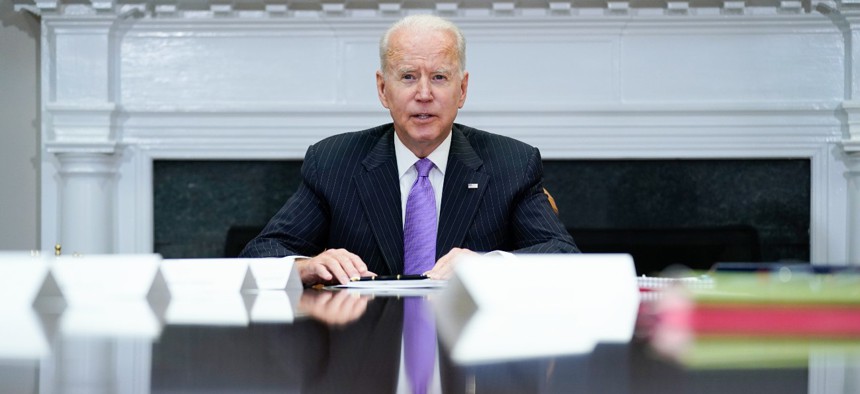
President Biden speaks during a meeting at the White House in June. Evan Vucci / AP
Biden Signs Sweeping Order to Improve Diversity, Inclusion and Accessibility Across Federal Workforce
All agencies will be required to submit a plan to improve their diversity initiatives, while OPM will be tasked with ensuring its various benefits programs are responsive to LGBTQ+ employees’ needs.
President Biden last week signed an executive order directing a comprehensive rethinking of how the federal government encourages diversity and inclusion among its workforce.
The order builds on a series of edicts undertaken during the Obama administration, as well as Biden’s own efforts to restore diversity training at federal agencies and crack down on discrimination since he took office in January. But it also charts new territory in how it tries to improve recruitment, retention and professional development of underserved communities, including providing more comprehensive health coverage to LGBTQ+ federal workers, boosting protections for feds with disabilities and pushing agencies to transition from unpaid to paid internships.
“As the nation’s largest employer, the federal government must be a model for diversity, equity, inclusion and accessibility, where all employees are treated with dignity and respect,” Biden wrote. “Accordingly, the federal government must strengthen its ability to recruit, hire, develop, promote and retain our nation’s talent and remove barriers to equal opportunity . . . The federal government should have a workforce that reflects the diversity of the American people. A growing body of evidence demonstrates that diverse, equitable, inclusive and accessible workplaces yield higher-performing organizations.”
The order tasks newly confirmed Office of Personnel Management Director Kiran Ahuja and Office of Management and Budget Deputy Director for Management Jason Miller, in consultation with the White House and the Equal Employment Opportunity Commission, with developing a governmentwide diversity, equity, inclusion and accessibility initiative. And individual agencies will be required to examine their own policies to evaluate the state of diversity initiatives within 100 days, and develop plans to “eliminate any barriers to success faced by underserved employees.”
Biden’s order casts a wide net, taking a holistic view of underserved communities who might benefit from a more equitable diversity policy; included in the order’s scope are people of color, women, members of the LGBTQ+ community, parents, caregivers, people who require religious accommodations at work, people with disabilities, first-generation professionals and college students, English language learners, immigrants, formerly incarcerated people, rural residents, veterans and military spouses.
The order encourages agencies to establish chief diversity officers within their organizations and expands federal employees’ access to diversity and inclusion job training programs, subject to guidance from OPM and the EEOC. It also requires the creation of a governmentwide plan to address workplace harassment, including sexual harassment, and enhanced policies to prevent, report, investigate and monitor instances of harassment.
During the last administration, former President Trump signed an executive order barring federal agencies and contractors from engaging in so-called “divisive” diversity job training programs, sparked by conservative activists’ accusations that some training programs engaged in “critical race theory,” an academic framework used primary in law schools to examine how racism persists institutionally rather than through personal animus.
Meanwhile, some federal employees reported commonplace incidents of racism and harassment in their workplaces. According to a survey commissioned by the American Federation of Government Employees last summer, 55.4% of Veterans Affairs Department employees said racism was a “serious problem” at the department, and 75.9% of respondents reported experiencing “racially charged actions” in the workplace.
Biden’s order also takes aim at a problem that has persisted despite efforts over the last decade to improve diversity of federal payrolls: the failure of agencies to promote women and people of color into positions of leadership, despite gains at lower levels of the organizational chart. In addition to ordering agencies to develop new recruitment partnerships with historically black colleges and universities and other post-secondary institutions that teach underserved communities, the edict directs agencies to improve the collection of demographic data about which federal employees can access agencies’ professional development and advancement opportunities.
A number of the order’s provisions are aimed at improving equity by bolstering workplace benefits and accommodations for some feds.
In the case of LGBTQ+ employees, the order calls on agencies, in coordination with OPM, to provide “support services” to transgender, gender non-conforming and non-binary employees if they wish to transition “legally, medically or socially.” It also instructs OPM and the Defense Department to cover comprehensive gender-affirming care through the Federal Employees Health Benefits Program and the Military Health System, respectively, and to ensure that LGBTQ+ employees, their dependents and beneficiaries all have “equitable” access to the federal government’s various health long-term care and life insurance programs.
And for federal workers with disabilities, the order directs agencies to work with the Labor Department and the U.S. Access Board to improve accessibility both at federal facilities and in the technologies used at work, as well as to make it easier for people with disabilities to request reasonable accommodations from their employer. It also orders a review of Schedule A hiring authority for people with disabilities with an aim to improving employment opportunities for people with disabilities.
In a statement, Ahuja said the various provisions of the executive order are modeled after best practices employed by private sector companies.
“This executive order will help in our efforts to recruit, retain and honor the most effective workforce, one in which federal employees from all backgrounds and walks of life feel included and valued,” she said. “These types of efforts are best practices for major employers across sectors seeking to stay competitive in the marketplace, and OPM is looking forward to working with all of our federal partners as we better position our workforce for the future.”







